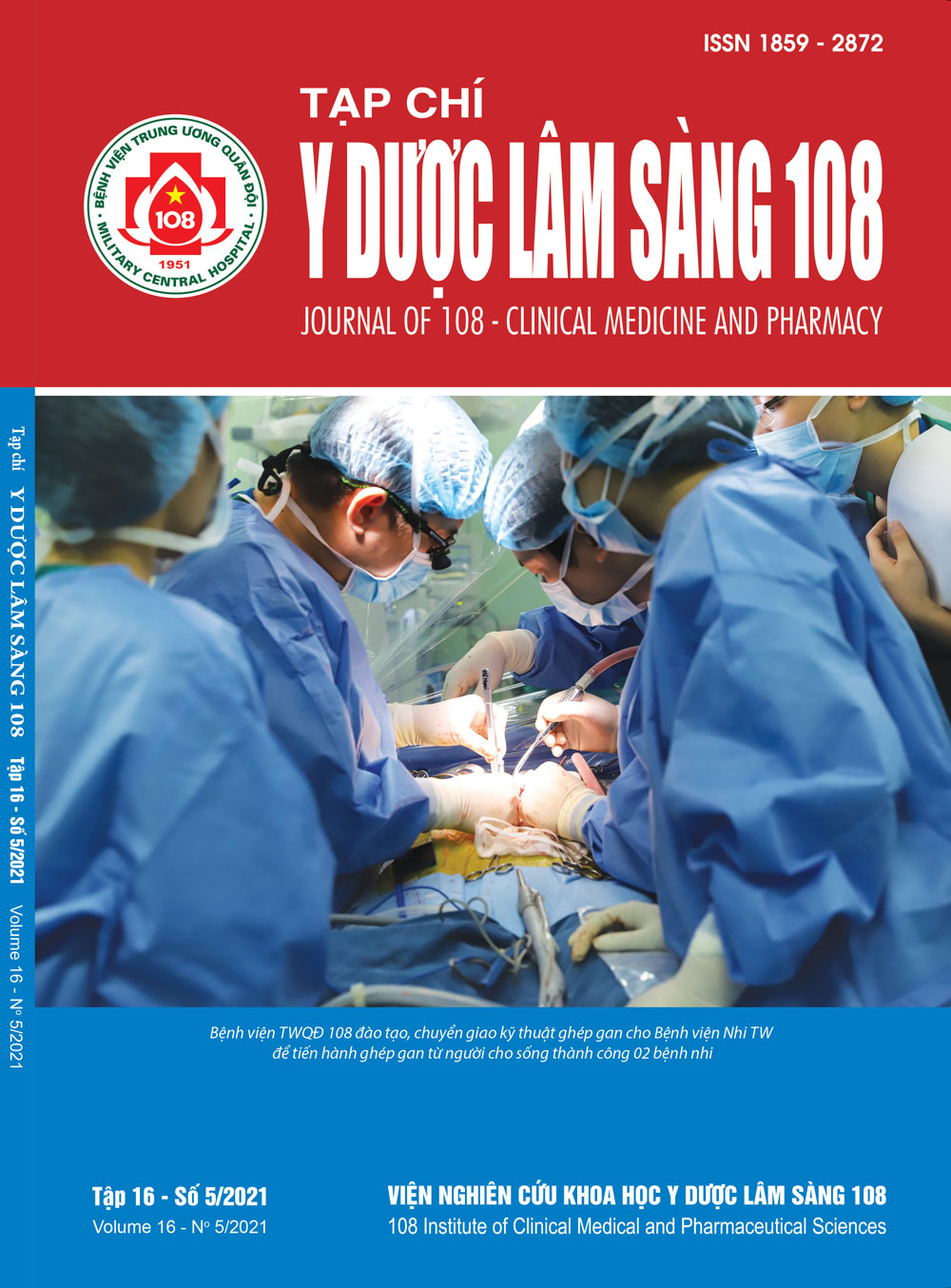Assessment of postoperative care of the maxilofacial trauma surgery patient at 108 Military Central Hospital
Main Article Content
Keywords
Abstract
Objective: To describe some clinical, laboratory features and analysis of results of care for patients with maxillofacial trauma operated at 108 Military Central Hospital. Subject and method: A cross-sectional study of 124 patients diagnosed with maxillofacial trauma and treated at the Maxillofacial and Plastic Surgery Department of 108 Central Military Hospital from 11/2020 to 5/2021. Result: Injuries were mainly found in men (75.81%), the majority aged 18 - 59 years old (87.90%). The main reason for admission was traffic accident (86.29%). The rate of swelling and swelling after surgery gradually decreased until the day of discharge to 35.48%; diagnosed by X-ray, the rate of fracture in the middle of the face was higher than that of the mandibular fracture with the rate of 73.39%. Surgical results had 01 patient, accounting for 0.81%, with surgical site infection; the rate of postoperative swelling decreased gradually, the first day was 100%, by the third day this rate decreased to 98.38%, the fifth day was 83.87% and the day of discharge was only 35.48%. Health education communication was over 80%; it is best to guide hospital regulations and use drugs exactly as indicated, accounting for 100%. Conclusion: The main cause of maxillofacial trauma was traffic accidents, men accounted for 3/1 compared with women, working age accounted for the majority. Injury to midface fractures accounted for more than 70%, macular tests show an increased white blood cell count and other biochemical and blood chemistry indicators within normal limits. The time from injury to hospital admission was more than 12 hours long (77.4%), 94.35% had swelling in the face. The results of surgical treatment were only 1/124 cases of surgical site infection, the nursing factors that greatly affect the treatment outcome were dressing change care, fluid drainage monitoring, analgesia care and health education for patients.
Article Details
References
2. Kai-Hendrik B, Sarah W, Nils-Claudius G, Horst K, Constantin S, Rainer S, Schön R (2009) Five-year retrospective study of mandibular fractures infreiburg, germany: Incidence, etiology, treatment, and complications. Journal of Oral and Maxillofacial Surgery 67(6): 1251-1255.
3. Hoàng Ngọc Lan (2014) Đặc điểm lâm sàng, khớp cắn và hình ảnh X-quang sau điều trị phẫu thuật bệnh nhân gãy xương hàm trên Le Fort I, II và gò má cung tiếp. Tạp chí Y học Thực hành, 10 (938)/2014, tr. 116-119.
4. Athanassios K, Georgios K, Argyro K, Nikolaos L, Konstantinos A (2013) Incidence,aetiology, treatment outcome and complications of maxillofacial fractures. A retrospective study from Northern Greece. Journal ofCranio-Maxillo-Facial Surgery 41: 637-643.
5. Bither S, Mahindra U, Halli R, Kini Y (2008) Incidence and patternof mandibular fractures in rural population: A review of 324 patients at a tertiary hospital in Loni, Maharashtra, India. DentTraumatol 24: 468-470.
6. Nguyễn Công Suất (2017) Ứng dụng nẹp vis MIMIPLATE trong điều trị gãy xương hàm mặt tại Bệnh viện Đa khoa tỉnh Quảng Ninh năm 2014 - 2016. Đề tài khoa học cấp bệnh viện, Quảng Ninh.
7. Arslan ED et al (2004) Assessment of maxillofacial trauma in Emergency Department. World J Emergency Surg 9: 13.
8. Majambo MH, Sasi RM, Mumena CH, Museminari G, Nzamukosha J, Nzeyimana A, Rutaganda E (2013) Prevalence of oral and maxillofacial injuries among patients managed at a Teaching Hospital in Rwanda. Rwanda J. Health sci 2(2): 20-24.
9. Phạm Văn Liệu (2011) Tổng quan về chấn thương gãy xương hàm mặt và phương pháp điều trị. Tạp chí Y học thực hành, (748), số 1/2011, tr. 20-23.
10. Trần Văn Trường, Trương Mạnh Dũng (2000) Tình hình chấn thương hàm mặt tại Viện Răng Hàm Mặt Hà Nội trong 11 năm (1988 - 1998) trên 2149 bệnh nhân. Tạp chí Y học Việt Nam 10: 27-36.
11. Kai-Hendrik B, Sarah W, Nils-Claudius G, Kokemüller H, Constantin Stühmer, Rainer Schmelzeisen, Ralf Schön (2009) Five-year retrospective study of mandibular fractures infreiburg, germany: Incidence, etiology, treatment, and complications. Journal of Oral and Maxillofacial Surgery 67(6): 1251-1255.
12. Ashok Thorat and Wei-Chen Lee (2013) Critical care issues after major hepatic surgery. Chapeter 4: 83-103.
 ISSN: 1859 - 2872
ISSN: 1859 - 2872
